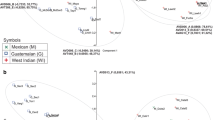Abstract
Fluorescent AFLP and automated data analysis were employed to assess the genetic conformity within a breeders’ collection of evergreen azaleas. The study included 75 genotypes of Belgian pot azaleas (Rhododendron simsii Planch. hybrids), Kurume and Hirado azaleas and wild ancestor species from the Tsutsusi subgenus. Fluorescent detection and addition of an internal size standard to each lane enabled the automated scoring of each fragment arising from a single AFLP primer combination (PC). The use of three PCs generated an initial data set with a total of 648 fragments ranging from 70 bp to 450 bp. Different marker selection thresholds for average fluorescent signal intensity and marker frequency were used to create eight extra restricted data subsets. Pairwise plant genetic similarity was calculated for the nine data sets using the Simple Matching coefficient (symmetrical, including double-zeros) and Jaccard coefficient (asymmetrical, excluding double zeros). The averages, the ranges and the correlation to one other (Mantel analysis) were compared for the obtained similarity matrices. This revealed the sensitivity of ordinations obtained by both similarity coefficients for the presence of weak or intensive markers or for the degree of polymorphism of the markers. For 34 cultivars, pedigree information (at maximum to the fifth ancestor generation) was available. Genetic similarity by descent (kinship coefficient) was turned into a genetic distance and correlated to the genetic conformity, as revealed by the different selections of AFLP markers (Mantel analysis). Use of a Simple Matching coefficient with no or moderate selection to signal intensity and excluding rare and abundant markers gave the best correlation with pedigree. Finally, the ordination of the studied genotypes by means of dendrograms and principal co-ordinate analysis was confronted with known or accepted relationships based on geographical origin, parentage and morphological characters. Genotypes could be assigned to three distinct groups: pot azaleas, Kurume azaleas and Hirado azaleas. Wild ancestor species appeared to be more related to the Japanese azaleas. Intermediate cultivars could be typified as crossings with Kurume or Hirado azaleas or with wild species.
Similar content being viewed by others
Author information
Authors and Affiliations
Additional information
Received: 3 September 1998 / Accepted: 25 March 1999
Rights and permissions
About this article
Cite this article
De Riek, J., Dendauw, J., Mertens, M. et al. Validation of criteria for the selection of AFLP markers to assess the genetic variation of a breeders’ collection of evergreen azaleas. Theor Appl Genet 99, 1155–1165 (1999). https://doi.org/10.1007/s001220051320
Issue Date:
DOI: https://doi.org/10.1007/s001220051320




